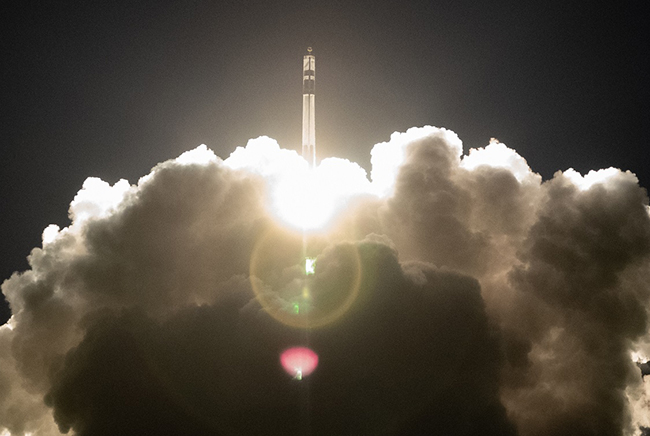
Rocket Lab's Electron launch vehicle lifts off for an Air Force space test mission May 5. The Air Force wants small payloads like those Rocket Lab carries to launch on 24 hours' notice, and could expand that to include heavier satellites. Photo courtesy of Rocket Lab.
A recent Air Force solicitation takes the first steps toward being able to order space launches on just 24 hours notice, a goal that would make the service more responsive to combat developments and avoid the weeks- or months-long waits typical of launches.
“The US Air Force is investigating the possible procurement of a capability to rapidly launch and deploy space payloads critical to national security in an ultra-responsive manner,” the service wrote in a May 30 sources-sought notice. “The objective is 24 hours from ‘call up’ notification to on-orbit capability.”
If industry doesn’t believe a 24-hour window is long enough, they should recommend a different time frame that would work in case of a national emergency, the Air Force said.
Air Force Acquisition Executive Will Roper told Politico in April the effort could let the service quickly put mission-specific satellites on orbit as combat needs change.
“They have to be ready to go on a moment’s notice,” he said. “In this case, rather than carry weapons or sensors into the flight, they’re going to be carrying satellites that provide that same functionality from a higher altitude.”
According to the recent posting, the service would start by demonstrating whether small payloads could make it to space on one days’ notice, but indicated it eventually wants to scale up to larger satellites. Demonstrations at first would “prove out the rapid space launch capability on an initially smaller scale,” according to the post, that added “solutions that can scale to orbits and payloads of national security value are also of great interest.”
At the Satellite 2019 conference in May, the heads of four major American space launch providers suggested it wouldn’t take a giant leap to meet the Air Force’s challenge. All are expected to compete for two slots in the service’s National Security Space Launch program.
It is absolutely possible, United Launch Alliance Chief Executive Officer Tory Bruno said, pointing to work the company has already done to cut down its production and launch turnaround.
For example, ULA’s new, reusable Vulcan rocket is expected to be ready to fly in 11 days, and a SpaceX booster takes up to a month and a half to prepare.
“You’ve got to change the cycle time by which you actually get a payload prepared,” Blue Origin CEO Bob Smith said. “It’s that entire chain that we actually have to go fix and make it more standard because right now, at this point, it’s very much a one-off, crafted type of mission that we do and that’s just requirements-based.”
Kent Rominger, Northrop Grumman’s vice president for the OmegA rocket program, pointed to a ready stock of solid rocket engines left over from intercontinental and submarine-launched ballistic missiles that can cut the time it takes to prepare for launch.
SpaceX President and Chief Operating Officer Gwynne Shotwell noted speeding time to launch can benefit commercial customers as well as military.
“The technology is there, it’s really the cost,” she said. “You either have a booster waiting on station and payloads loaded in fairings or you change some things, but the technology’s available today to fly in a couple of days.”
According to the sources-sought notice, the Air Force is planning a rapid space launch industry day July 29-30 in California, followed by studies, tabletop exercises, and demonstrations.
“For the demonstration, the intended orbit is low Earth orbit and the intended payload is a single Evolved Expendable Launch Vehicle Secondary Payload Adapter class space vehicle or smaller, with a mass up to 220kg,” the service said.
DOD is newly focusing on sending communications and hypersonic missile-defense satellites to LEO as the Space Development Agency’s first project. The Air Force is similarly researching satellite constellations that are resilient in part because a system could be replaced soon after it becomes unusable.
“The demonstration scenario will be based upon a rapid reconstitution requirement in response to an unforeseen event,” the Air Force said. “Survivability [the ability to withstand or avoid attack] of the rapid space launch capability is not a requirement of the demonstration, but will be a consideration for future operational capabilities.”